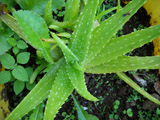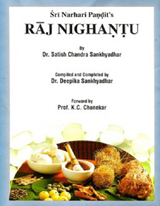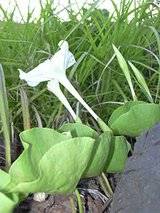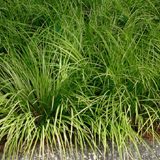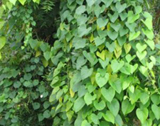Medicinal plants
Principles of plant taxonomy
A fresh insight into the ancient Indian methodology and philosophy of naming and classifying medicinal plants
Abstract
Proper nomenclature and classification play important roles in the systematisation of any branch of knowledge. In this regard, the ancient Indian ṛṣis and ācāryas had shown much transparency in their scientific observations. For them to name was to touch the essence of the thing or object named. They could really enter into the soul or the consciousness of the thing or the object and then give the name according to their experience. We find a clear reflection of this in the names of the plants as they appear in various texts of Āyurveda. From the various names given to one plant, one can truly understand not only the various morphological characteristics of that plant but also the special medicinal properties that the plant has. This paper brings a fresh insight into this aspect and throws light on the ancient Indian methodology and philosophy of naming and classifying medicinal plants.
Introduction
Sir William Jones, Founder-President of the Asiatic Society of Bengal once wrote, “I am very solicitous to give Indian plants their true Indian appellations, because I am fully persuaded that Linnaeus himself would have adopted them had he known the learned and ancient language of this country… (1)”
This suggestion needs serious attention, especially from Indian botanists. The ancient Indian naming of plants, as found in the various texts dealing with the subject, is an extremely interesting topic which gives us an indication not only of the geography of India but also highlights the fact that our ancestors had a keen sense of observation. In the texts dealing with the names of plants, we find that a plant is referred to by many names. A proper analysis of all the names of a particular plant reveals that each name describes a particular feature (svarūpa) or a specific quality/property (guṇa) of that plant. So, all names can be of two types: svarūpa-vodhaka-nāma and gunna-vodhaka-nāma. However, the names of the plants are coined on the basis of varied criteria. Before I deal with the details of these criteria, let me give you an idea about the various classifications of the plants done by various sages and ācāryas of ancient India.
Classification of plants
The ancient Indian classification of plants was based on three major considerations, namely udbhīda or botanical, virecanādi or medicinal, and annapānādi or diet-related. This classification, however practical or impractical it may be from the present standpoint, has provided a working basis for botanists, physicians and agriculturists of India for a very long time.
It is obvious from various Sanskrit texts that the ancient Indians did recognise different kinds of plants based on their habits. They also recognised plants that bear flowers and fruits and those that do not. Thus, Manu, the famous author of Manusmrrti, classified plants into eight different types (2):
1. auṣadhis or those that bear abundant flowers and fruits, and that wither after maturing, e.g. rice and wheat.
2. vanaspatis or those that have fruits but no evident flowers, e.g. Auster fig, (udumvara).
3. vṛkṣas or those which produce flowers and fruits, e.g. Neem (nimba).
4. gucchas or bushy herbs of various types, e.g. Jasmine (mallikā).
5. gulmas or succulent shrubs of various types, e.g. Nerium.
6. tṛṇas or different kinds of grass, e.g. Cuscus (uśīra).
7. pratānas or creepers with stems spreading on the ground (procumbent and decumbent), e.g. prasāriṇī.
8. vallis or those which twine around or climb up a tree for support, e.g. guḍuci.
Ācārya Caraka gives a different classification of plants (3). According to him, trees that bear fruits without flowers are vanaspatis; trees that first bear flowers and then fruits are vānaspatyas; herbs with spreading stem are called vīrudhas and they are further divided into two classes such as creepers or latās and herbs with succulent stems and shrubs or gulmas; those herbs that wither after maturing are auṣadhis and which are further divided into two groups such as: annuals or perennials, bearing fruit, and plants that wither away after maturing and without fruiting, e.g. grasses like the Bermuda grass (dūrvā).
Ācārya Suśruta lays down an almost similar classification of plants (4). According to him, there are four varieties of plants, such as trees which bear fruit without blossoming (vanaspatis); those that bear both fruits and flowers (vṛkṣas); shrubs and creepers that trail (vīrudhas); and plants which die with the ripening of their fruits (auṣadhis).
Apart from the above-mentioned ācāryas, Udayanacharya (5), the author of Kiraṇāvali, Prasastapada (6), the Vaīśeṣika commentator, and Amara Simha, the author of Amarakośa (vanauṣadhivarga) have dealt with the botanical classification of the plants in great detail. The Bhāgavata Purāṇa also deals with the classification of plants in its 3rd skanda, 10th Chapter, verse No. 19.
In the ancient Indian medicinal treatises, plants were studied mostly in relation to their medicinal properties or values. Thus we see that Ācārya Caraka classifies plants primarily into two divisions — purgatives or virecanādi and astringents or kaṣāyādi (7). According to him, there are six hundred purgatives and five hundred astringents. Ācārya Caraka puts these herbs under various groups or vargas like jīvanīya or those prolonging life, lekhanīya or those reducing obesity or thinning the tissues, dīpanīya or those promoting appetite and digestion, etc. This classification of Ācārya Caraka is based on the finer properties of the plants (8). Ācārya Suśruta classified plants under thirty-seven sections or gaṇas depending upon their medicinal properties and named them after the most important medicine of that group (9). For example, the group rodhrādigaṇa has plants which are antidotal to upset kapha (10).
Similarly we also find a detailed classification of the plants done by various ācāryas based on their diet-related values. Ācārya Caraka (11) recognised six groups of plants based on diet-related values and Ācārya Suśruta (12) recognised fifteen different groups.Amara Simha (13) in his Amarakośa lists the names of various grains in vanauṣadhivarga and vaīśyavarga.
Nomenclature
The ancient Indian plant names were based on several parameters. Works like Rājanighaṇṭu and Dhanvantari Nighaṇṭu have given an outline of these parameters. Here I take up the parameters given in Rājanighaṇṭu of Pandita Narahari. Rājanighaṇṭu prescribes seven criteria for deriving names (14):
1. Tradition of usage (rūḍhitaḥ) — for example, Ocimum sanctum is named as kṛṣṇatulasī because it is used in the worship of Kṛṣna and its leaves are a blackish-green in colour.
2. Properties (svabhāvataḥ) — for example, Embelia ribes is named as kṛmighna which indicates that this plant kills worms. Or, Eclipta prostrata is named as keśarañja or that which blackens the hair.
3. Local names (deśokti) — Gynandropsis gynandra is named as hurahurā which is a local name but it is adopted in the scripture because of popular usage.
4. Special morphological characteristics (lāñchanā) — for example, Ricinus communis denotes the palm-like leaf of the plant and is named as gandharvahasta meaning ‘like the hands of celestial beings’.
5. Similarity or resemblance (upamā) — for example, markattahastatrinna is a beautiful descriptive name indicating the spikes of the plant Eleusine genus which resemble the fingers of monkeys.
6. Potency (vīrya) — the plant Plumbago rosea is named agni because of its potentiality to digest and promote metabolism.
7. Place of growth (itarāhvayādideśāt) — Vanda roxburghiana is named as vṛkṣārūha because it grows on trees.
Here is the original verse of the Rājanighaṇṭu that gives the above description:
nāmāni kvacidiha rūḍhitaḥ svabhāvāt deśoktyā kvacana ca lāñchanopamābhyām vīryeṇa kvaciditarāhvayādideśāt dravyāṇāmiti saptadhoditāni (Rājanighaṇṭu, grantha-prastāvanā 9).
Apart from this, we find several other parameters enumerated in other texts. Sometimes we see that the names of certain plants denote some of their special features. For example, the Rape seed or raktasarśapa, being small in size, has the name aṇu which means small or minute. Similarly, the name prasāriṇī refers to a creeper that spreads on the ground and vṛkṣarūha refers to a plant that grows on trees. At times, certain names denote the morphological characters of the plants.
A. Names denoting morphological characters
1. Root
a. bahupādam is a name of the Banyan tree which indicates that it has numerous roots.
b. Sweet Flag is named as śataparvika. This indicates that the rhizome of this plant has a hundred or many nodes.
2. Knots
a. Long Pepper, popularly known as pippalli, has another name granthikā which indicates that the roots of this plant have a knotted, swollen appearance.
b. White birch bark is known as bhūrjagranthi or that which has knots or granthi-like fungal formations (bhūrja).
3. Bark
a. Bamboo is known as tvaksāra because the stem of the bamboo is hollow. There is no heat-giving wood. Hence the name means the bark itself is the core structure.
b. The bark tree or Betula util is named as valkadrumam because its bark is used for a medicinal purpose.
4. Leaves
a. Each leaf of the pṛāśniparṇī (Urarialagopoides) is composed of three leaflets, so the name for this plant is triparṇī.
b. Biton Bark, a plant with seven leaflets is named as saptaparṇa.
5. Flowers
a. The flowers of the Indian Laburnum (aragvadha) are a golden-yellow in colour, so this plant is named suvarṇaka.
b. The flowers of the Cobra’s Saffron (nāgakesara) resemble snakes in appearance, so it is named nāgapuṣpa.
6. Seeds
a. The Horse Radish (raktasigru) is known as kṛṣṇabīja because its seeds are black in colour.
b. Since the seeds of the Castor Oil plant (Ricinus communis) have various marks on them the plant is named citrabīja.
7. Spines
a. The fruits of the Small Caltropis (Gokshura) have spine-like projections that resemble the teeth of a dog, so the name given to this plant is śvadaṁṣṭra.
8. Latex
a. The latex of the roots of the Kashmiri Hirtiz (Euphorbia thomsoniana) is a golden-yellow in colour, so it is named as svarṇakesarī.
B. Names denoting comparisons of plant morphology to other familiar objects
1. Leaves of the Ipomea reniformis resemble the ears of rats so the plant is named ākhukarṇī.
2. The name halinī is used for the Superb Lily as its rhizomes resemble a plough in appearance.
3. Black Musale is named as musalī because its tubers resemble the pestle in appearance.
4. Butterfly Pea, popularly known as aparājītā, has another name, śaṅkhapusspī, because its flowers resemble a conch shell in appearance.
5. Ricinus communis is named as pañcangulm because its leaves are like a [human] palm with five fingers.
6. Musk root is known as jātamāmmsi because its roots resemble matted hair.
C. Names denoting place of origin, habitat, flowering season, etc.
1. Place
Cardamom is known as drāviḍī because it is a south Indian crop.
2. Habitat
a. Sacred Lotus is known as jalaja because it grows in water.
b. Similarly giri-mallikā which grows in mountains is known as kūṭaja.
3. Season
a. The bakula or Mimusopsel engi is known as śāradika because it flowers in autumn.
b. Swallow Worts or arka flowers in all seasons so it is named as sadāpusspa.
D. Names denoting properties of plants
1. Colour
Turmeric is known as pīta because its rhizome is yellow in colour.
2. Odour
a. Sweet Flag (vaca) is also known as ugragandhā because it has a characteristically strong smell.
b. Winter cherry is known aśvagandhā because it emits a smell like that of the body odour of a horse.
3. Taste
The plant cireta is bitter in taste, so one of its names is tikta.
4. Touch
The leaves of the bharaṅgi (Clerodendrum serratum) are rough, so it is named as kharaśāka.
5. Potency
a. Black pepper is hot in potency, so one of its names is uṣṇa.
b. White Sandalwood tree is cool in potency, so one of its names is śīta.
6. Special action
Ipomoea sepiaria cures sterility and bestows one with progeny so it is known as putrada.
E. Names denoting pharmacological actions
1. The plant popularly known as viḍaṅga is a good anti-helmenthic so one of its names is kṛmighna,meaning worm-killer.
2. Elephant’s Foot (Amorphophallus) cures rectal haemorrhoids and is known as arśaghna.
3. Aerva lanata is known as pāṣāṇabhedī because it has the potency to dissolve stones in the gallbladder.
F. Names denoting utility
1. Bastard teak, popularly known as palāśa is used in fire sacrifices so it is otherwise known as yājñīka.
2. The wood of the Lagerstroemia parvi flora is used for making chariots, so it is known as syandanadruma.
3. Bamboo, popularly known as vammśa, is used for making bows, so it is also known as dhanudruma.
G. Names denoting important events
Bodhidruma is the name of the Sacred Fig tree because the Buddha became enlightened under this tree.
H. Names associated with mythology
1. Guduchi is also known as amṛtasambhava because it is believed that it originated from ambrosia.
2. Pinus deodara, popularly known as devadāru is also known as indravṛkṣa because in Indian mythology it is said to be the tree of Indra, King of the Celestials.
Thus, we see that the ancient Indian ācāryas had a keen sense of observation which guided them in naming and classifying plants. We see that although a plant may have many names, one of its names is used prominently and all others are its synonyms. So the prominent or most popular name is the pradhānanāma or basionym and the others are upanāmas or secondary synonyms. Sometimes we see that the secondary name of a plant is also used as the secondary name of another plant or plants. On the basis of this, the nighaṇṭukāras have categorised these names as ekārthas or one name applied to only one plant; dvayārthas or one name for two plants; tryārthas or one name for three plants, etc. (15).
Unique set of names for a plant
In this section, I take up the different names of one plant to show what the various names attributed to the plant indicate(16).
Guḍuci or Tinospora cordifolia is a climber with long offshoots; rich in foliage and sap; the leaves of which are used as vegetables; its mature stem is a blackish-green in colour; it has no thorns; it has a bitter taste; it promotes good health and imparts longevity and is beneficial in action; cattle love to eat its leaves; it is capable of rejuvenating itself from the cut bits of the stem; and its fibrous shoot was used in surgery for suturing. This is the description of this plant. Now let us look at the different names of this plant given by the ancient Indian ācāryas (17).
The very name guḍuci is derived from the root word ‘guḍ’ which means ‘to guard or protect or preserve’. This indicates the high potentiality of the plant. The names, amṛtavallī, amṛtavallarī, amṛtalatā, somavallī and somalatikā indicate its life-giving properties and nourishing ability. The name maṇḍalī indicates that the stems of this plant entwines in a circular fashion; kuṇḍalī indicates that the stem gets entangled while it twines; nāgakumārī indicates that the stem has a twining nature comparable to that of young snakes; tantrikā points out the spreading nature of the plant; tantrī indicates its tough rope-like nature; chadmikā refers to its thick foliage; vatsādinī indicates that its leaves are eaten by calves; śyāmā refers to the black green colour of its stem; dhārā indicates that the young stems of this plant have slightly longitudinal grooves; cakralakssannā indicates the appearance of the stem in cross-section; viṣalyā indicates that the plant has no thorny or irritant appendages; the names chinnā, chinnarūhā, chinnodbhava and chinnāngī refer to the undying nature of the stem or stem bits; avadhikāhvayā refers to the richness of sap in its stem and leaves; amṛta indicates that the persons using this plant would live a long, and healthy life; soma refers to the powerful action of the plant as an elixir; the names rasāyanī, vayasthā and jīvantī refer to the rejuvenating nature of the plant; jvarāśinī and jvarāri refer to the specific use of the plant for reducing fevers; bhiśakapriyā and bhiśakajitā signify that this plant is the favourite of the physicians; varā indicates that it is the best among medicines; soumyā, candrahāsā and chandahāsā indicate its nature of benevolence in action; devanirmitā, amṛtasambhavā and surakṛtā indicate the divine origin of the plant (18).
One of the most important and special properties of this plant is that it strengthens the flame of the heart. So, vakṣāgnidipanī is one of its prabhāvas (strengths and effects) as described in Āyurveda. Vakṣa means ‘chest’ or ‘heart’ in Sanskrit. Agni means ‘flame’, while dīpanī means ‘strengthening the flame’.
A careful study of several Āyurveda texts, especially the nighaṇṭu-granthas, containing the names of the plants and the various commentaries available, confirms that this system of naming the plants has its own limitations and disadvantages. The widespread use of many names for a single plant and one name referring to many plants has resulted in great confusion; also, there is a great diminution of traditional expertise in identifying plants. Classical treatises dealing with the classification of plants do not use consistently the principal names of the plants, so in most of the cases it is not possible to know what the principal name of a plant is. Commentators also differ in their view with regard to the identification of the plants. The lexicographers, the scribes of the manuscripts, the texts suggesting use of substitutes, all these have contributed towards the great confusion in this field. However, a detailed and comparative study of ancient medicinal as well as non-medicinal treatises dealing with plant sciences can enable us to understand better not only the principles but also the advantages and disadvantages in the ancient Indian naming and classifying of plants.
Conclusion
The ancient Indian ṛṣis believed that each and every element in this creation has a consciousness. There is nothing without consciousness. With this understanding, when the ancient Indian botanical scientists dealt with plants they could feel the consciousness of the plants. As Manu says, “tamasābahurūpennavessttitākarmahetunā / antahhsammjñābhavantyetesukhaduhhkhasamanvitāh1h (19).”
“Though it seems that plants are covered by tamas yet they are conscious within and because of this they feel pleasure and pain.” We also see it in the Yogavāśiṣṭha (6.1.10.23) (20) where Sage Vasishtha makes it clear that the consciousness-power (citśakti) lies dormant in all that is inanimate (citśaktirvāsanābījarūpiṇīsvāpad-harmiṇīsthitārasatayānityaṁsthāvarādiṣuvastuṣu). Udayana, in his book, Kiraṇāvali under the section pṛthvīnirūpaṇa, speaks about the phenomena of life, death, sleep, disease and movements in plants. Gunaratna, in his commentary on Śaḍdarśanasamuccaya also deals with plant consciousness and gives a list of plants that display the phenomena of sleeping and waking.
The Buddhist logician Dharmottara in his Nyāyavinduṭīkā records the phenomenon of sleep in certain plants, in the form of contraction of their leaves during the night. Sankara Mishra in his Upaskara mentions the bhagnakṣatasomārohaṇa of plants, which means that there is a natural healing after injury due to the growth of organs. The Shantiparva (184-10-17) of the Mahābhārata enumerates several physiological principles including the sense of touch, hearing (response to sound), vision, smell, irritability, etc. in respect of plants (21).
In modern times, scientists like J.C.Bose and others also confirmed the truthfulness of the above facts. “To find out whether the plant perceives and reacts to a shock, the stem is placed between a fixed rod and a movable magnifying lever, the movement of which is further magnified by optical means to something like a million times. The experiment described was carried out before a group of world-famous scientists of the University of Vienna. A very feeble electric shock was sent through the plant, and through one of the leading physicians who was in the same circuit. The human being felt nothing, but the Contraction Recorder showed that the plant gave a shuddering twist under the shock (22).”
Sri Aurobindo states,“Chit, the divine Consciousness, is not our mental self-awareness; that we shall find to be only a form, a lower and limited mode or movement. As we progress and awaken to the soul in us and things, we shall realise that there is a consciousness also in the plant, in the metal, in the atom, in electricity, in everything that belongs to physical nature; we shall find even that it is not really in all respects a lower or more limited mode than the mental, on the contrary it is in many ‘inanimate’ forms more intense, rapid, poignant, though less evolved towards the surface (23).”
It was with this attitude that the ancient Indian medical scientists and botanists dealt with plants. Although parīkṣā or investigation was one of the prominent means for them to validate their knowledge yet they relied mostly on their intuitive mind. Discovering by intuition and developing by logic was their method in systematising knowledge. If we see how the Mother of the Sri Aurobindo Ashram gave spiritual names to hundreds of flowers, it will help us to understand the ancient Indian methodology and philosophy of naming and classifying plants. Once, one of the disciples asked the Mother, “Mother, when flowers are brought to you, how do you give them a significance?” The Mother replied, “…by entering into contact with the nature of the flower, its inner truth. Then one knows what it represents (24).”
It was with this spirit that the ancient Indian ācāryas gave names to everything, by entering into the soul and nature of the thing. The thousands of names of plants available in various ancient treatises are the expression of this inner contact with the nature and soul of the plants.
References and end-notes
1. Jones W. Botanical Observation of Select Indian Plants. Volume 4. Kolkata:Asiatic Society of Bengal, Calcutta. Asiatic Researches. 1795; pp. 237-312.
2. Müller M (ed). Sacred Books of the East: The Laws of Manu.Volume 25. Bühler G (trans). Oxford: Oxford University Press; 1886, pp. 46-8.
3. Sharma PV (ed.). Carakasammhitā. Varanasi: Chaukhamba Orientalia; 1981, pp. 36-7.
4. Bhishagrathna KL (ed.). Suśrutasaṁhitā. Varanasi: Chaukhamba Orientalia; 1991 p. 23.
5. Sarvvabhouma SC (ed). Kiraṇāvali by Udayanacharyya: with the commentary of Vardhamanopadhyaya. Asiatic Society of Bengal, Calcutta: Bibliotheca Indica New Series No. 1277; 1911, p. 256.
6. Dvivedin V (ed). Bhāshya of Prasastapada, Volume 4. Varanasi: E.J. Lazarus and Co., Vizianagram Sanskrit Series; 1895, p. 28.
7. Sharma PV (ed.). Carakasammhitā. Varanasi: Chaukhamba Orientalia; 1981,Chapter 4.
8. Majumdar GP. Plants and Plant-life as in Indian Treatises and Traditions. Kolkata: University of Calcutta; 1927, pp. 90-8.
9. Bhishagaratna KL (ed.). Suśrutasaṁhitā. Sūtrasthāna.Varanasi: Chaukhamba Orientalia; 1991, Chapter 38.
10. Majumdar GP. Plants and Plant-life as in Indian Treatises and Traditions.pp. 98-104.
11. Sharma PV (ed.). Carakasaṁhitā. Sūtrasthāna Chapter 27.
12. Bhishagratna KL (ed.). Suśrutasaṁhitā. Sūtrasthāna. Chapter 46.
13. Majumdar GP. Plants and Plant-life as in Indian Treatises and Traditions, pp. 105-27.
14. Sharma, VN (ed.). Rājanighaṇṭu and Dhanvantari-nighaṇṭu. Pune: Anandashram Press; 1986.
15. Sharma, VN (ed.). Rājanighaṇṭu and Dhanvantari-nighaṇṭu. Pune: Anandashram Press, 1986, Chapter 23-33.
16. Dwivedi V. Bhāvaprakāsha-nighaṇṭu, guḍucyādivarga. 6th ed. Delhi: Motilal Banarsidass Publishers; 2015, pp. 6-10.
17. Oka KG (ed.). The Nāmaliṅgānuśāsana (Amarakoṣa) of Amarasimha, with the commentary of Kshirasvamin, (ed.) Khadekar DG. Vanauṣdhivarga; 1913, 83.
18. There is an interesting legend about the origin of this plant from the nectar given in the beginning of the guḍucyādivarga of Bhāvaprakāsha-nighaṇṭu (1-5). After Ravana was defeated, Lord Rama saw that a lot of monkeys and bears had been killed during the war. The monkeys and bears had joined Rama to form his army. Rama prayed to Indra, king of the gods and keeper of the amṛta (nectar of immortality), to bring the monkeys and bears back to life since they had died helping to establish peace on earth. Indra granted this boon and sprinkled amṛtam (nectar) from the heavens on the dead bodies of the monkeys and bears. Some drops of nectar fell on the monkeys and bears, bringing them back to life, and some drops fell on the earth. The drops of nectar that fell on the ground became guḍuchi plants.
19. Müller M (ed). Sacred Books of the East: The Laws of Manu, Volume 25. Bühler G (trans). Oxford: Oxford University Press; 1886, p . 47.
20. Pansikar LS (ed). The Yogāvasissttha of Valmiki: with commentary Vāsissttha Mahārāmāyanna Tātparyaprakāśa Volumes 1 and 2. Delhi: Motilal Banarasidass Publishers; 2008.
21. Sukhtankar VS, Belvalkar SK, Vaidya PI (ed). The Mahabharata for the first time Critically Edited (19 Volumes). Pune: Bhandarkar Oriental Research Institute; serially published between 1933-1966.
22. Dibakar S, Chakraborthy AK (ed). J.C. Bose Speaks. Kolkata: Puthipatra; 1985, p. 355.
23. Sri Aurobindo. Birth Centenary Library, Volume 20. Pondicherry: Sri Aurobindo Ashram Trust;1970, p. 371.
24. The Mother. Collected Works of the Mother, Volume 5. Cent ed. Pondicherry: Sri Aurobindo Ashram Trust; 1976, p. 232.
Secondary sources used for the preparation of this paper
1. Manohar R. Nomenclature and Taxonomy in Vrikshayurveda. Chennai: Centre for Indian Knowledge System; 1994.
2. Majumdar GP. Plants and Plant-life as in Indian Treatises and Traditions. Kolkata: University of Calcutta, 1927.
3. Sivarajan VV, Robson NKP. Introduction to the Principles of Plant Taxonomy. Cambridge. Cambridge University Press, 1991.
1 “Enveloped by excessive tamas and owing to past actions, though the plants seem to be deprived of consciousness, they are not. The consciousness in plants is dormant or latent and that is clear from the plants that they feel pleasure and pain”.
Dr. Sampadananda Mishra is Director of the Sri Aurobindo Foundation for Indian Culture (SAFIC) at Sri Aurobindo Society, Pondicherry.
Share with us (Comments,contributions,opinions)
When reproducing this feature, please credit NAMAH,and give the byline. Please send us cuttings.

